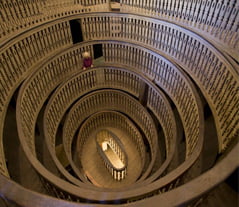 Padova’s anatomical theater was the world’s first permanent structure built to promote the study of anatomy through dissections. It is located in the center of Padova inside of Palazzo del Bo, which houses the headquarters of the University of Padova. Conceived by famed surgeon Girolamo Fabrizi d'Acquapendente in 1594, the purpose of this anatomical theater was to allow medical students to witness human and animal dissections in real-time.
Padova’s anatomical theater was the world’s first permanent structure built to promote the study of anatomy through dissections. It is located in the center of Padova inside of Palazzo del Bo, which houses the headquarters of the University of Padova. Conceived by famed surgeon Girolamo Fabrizi d'Acquapendente in 1594, the purpose of this anatomical theater was to allow medical students to witness human and animal dissections in real-time.
The practice of human dissection was considered taboo in most cultures from antiquity until the 17th century. Before the construction of Padova’s theater in 1595, anatomical dissections were performed on collapsable wooden platforms that would be dismantled immediately after. Though not necessarily illegal at the time of the theater’s founding, human dissection was not exactly embraced by the general public. Padova’s anatomical theater led the way in advancing the study of anatomy in the 17th and 18th centuries, making the benefits of human dissection widely known and eventually reversing public opinion.
Padova’s anatomical theater is the oldest surviving theater of its kind and it is perfectly preserved, appearing today as it did when it was constructed in 1595. “This is a place where the dead are pleased to help the living” has become an unofficial motto of the theater, taken from a 16th century Latin inscription written above the theater’s entrance. Visitors to Palazzo del Bo can observe this inscription as well as the original dissection table which to this day remains in the center of the theater.
The anatomical theater of Padova has a characteristic elliptical shape modeled after ancient Roman amphitheaters that allows sound to easily travel through the structure. It is composed of six, sloping wooden tiers capable of holding a maximum of 300 people. The tiers were designed so that students could easily follow the dissection happening on the ground floor’s central table. Beneath the dissection table is a trapdoor from which the cadavers would be brought into the theater via an underground passage. The theater originally featured a retractable roof that would help remove any unpleasant odors generated during the course of the dissections.
After its construction, the theater’s fame grew quickly, attracting influential anatomists from all over the world such as Andreas Vesalius, the father of modern human anatomy. These anatomists were assisted in their dissections by two students called massari who also had the job of acquiring the cadavers. For much of the theater’s history, the dissections were performed on the cadavers of criminals who had been sentenced to death.
Those who visit Palazzo del Bo to admire the anatomical theater will find a building rich with history. The structure is the seat of the University of Padova, which is the second oldest university in Italy after the University of Bologna. Famous alumni include astronomers Nicolaus Copernicus and Galileo Galilei, who was also a professor of mathematics. Galileo’s original chair and lectern used during his tenure at the university can be observed in the building’s Sala dei Quaranta. Ultimately, a visit to Padova’s anatomical theater and Palazzo del Bo can prove exciting not only for those interested in anatomy and medicine, but also for lovers of history, architecture, and the bizarre. Truly, no other building has impacted the study of anatomy and medicine quite like the anatomical theater of Padova.